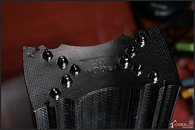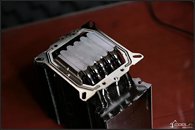Yeah, but the heatpipes that do make contact with the hotspots work much more efficiently than the old design with a spreader. How else do you explain a Xigmatek HDT-S1283 keeping pace with a TRUE? In short, those heatpipes that do make contact with the hotspot work much more efficiently, to the point where they keep pace with all 6 pipes under the spreader of something like a TRUE, rendering the difference in heat spread on an HDT cooler meaningless. AKA: All that matters is the end result.
The waste comes in the form of cost by having more heatpipes than needed. If these companies would make the heatpipes near gapless, I don't think any standard cooler would stand a chance.
According to Xigmatek the "secret" behind the HDT S1283's performance is the heatpipe diameter and not only the HDT. It means that more heat is able to be immediately transferred.
A spreader slows down heat transfer guys, when you compare it to heatpipes. Heatpipes immediately transfer heat to the fins (in a rapid oscillation), whilst copper "slowly" transfers it. The faster the rate of transfer the better.
I think Xigmatek's quality control has taken a dump when you look at their recent coolers, with old batches of HDT S1283 sometimes besting them. This is my theory, I reckon its because now they have a higher demand and the finishing process is done faster; with faster machinery to lap the cooler, you get more friction, thus a lot of heat. Too much heat will permanently increase the pressure of the vapor chamber (somehow... dunno), causing the heat transfer to be slightly less (seems more like "significantly less" to me recently).
Just note its probably impossible for thicker heatpipes unless we have another material which provides the same heat transfer characteristics, but with more structural integrity, as anything wider will need a much thicker interior, or the pipe would collapse on itself.'
Hopefully 3R's cooler will have more consistent quality, as its made by a completely different company. I've noticed that non-Xigmatek manufacturing offerings these days best their quality so the aforementioned theory may be right. This would be the boss of cooling.
+1 Agreed. The heatpipes need to be very close to the surface but still require a copper block (to provide thermal transfer and to provide some thermal capacity) on the IHS.
A copper block logically speaking transfers heat slower than heatpipes (they're heat superconductors), such a small block moreover lacks any "thermal capacity" and it is NOT supposed to store heat-that is the LAST thing that you want. Why don't you guys think through it before you believe every source of information?
One classic case which displays what I just said is Scythe's coolers which are heavily limited by their exceedingly thick copper blocks which negate the "speed" advantage of their extreme heatpipe arrays (Orochi). Someone give them a wakeup call please?
Don't take recent review results of Xigmatek coolers into account, because there seems to be a quality issue, if an old Xigmatek HDT S1283 outdoes half of the quad pipe coolers.
Direct heat pipes are a poor idea - there's a reason the worlds FASTEST i7 using air cooling achieved this without them - and instead uses a cooler with a spreader plate.
The heat from a CPU does NOT come evenly from the cpu cap - rather from hotspots caused by the placing of the cpu die(s).
As a result the heat pipes on the edges are almost completely un-used and the efficiency of the cooler as a whole is reduced.
(YES i know they still work well, but they would work BETTER if all of their heat pipes where conducting heat away from the cpu - and they don't)
Someone had thermal imaging reviews to prove this (as it seemed ppl couldnt understand the concept) , but I cant find the review anymore - I was sure it was toms h/w ...
Anyone know who it was?
Read what I said above

















